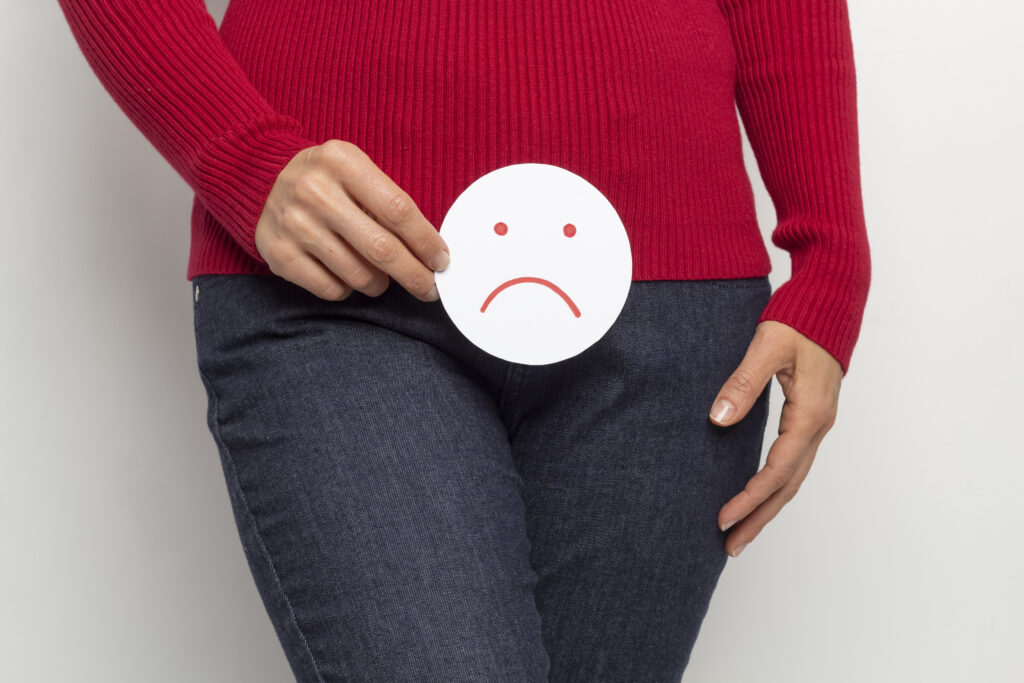Your vulva can be a source of pleasure and pain. Living with pain or potential pain is difficult and no one should be expected to endure pain. Many women struggle with sexual pain at some point in their life. According to the American College of Obstetrics and Gynecology, 3 out of 4 women will experience pain during intercourse. So common and yet many women have never heard the terms: Vaginismus and Dyspareunia. Megan Trainor recently talked about her struggle with Vaginismus.
What are the Symptoms?
Vaginismus is an involuntary tightening of the pelvic floor and vaginal muscles, often causing painful penetration during sex. Some women with vaginismus have a fear of penetration, while others fear potential pain or the disruption of their lives, relationships, or bodies. Dyspareunia is recurrent genital pain associated with sexual activity stemming from Vaginismus. It should also be noted that pain doesn’t necessarily have to be only in the vaginal opening, it can be anywhere on or in the vulva as well as your hips, stomach, and back areas. Your vulva is all of the external parts (ex, labia, clitoris) as well as your vagina.
These conditions have been difficult for clinicians to distinguish between causing the conditions to be folded into one disorder in the Diagnostic Statistical Manual of Mental Disorders-(fifth edition) called Genito-Pelvic Pain/Penetration Disorder (GPPPD). This is noted only to indicate the change since it may be used by professionals. Insurances require a diagnosis from the DSM in order to pay for sessions. That said, I am not of the belief that vaginal pain is a mental illness nor is it any indicator of issues with desire or arousal. Unless it is part of your sexual fanatasies, most don’t get aroused when they are experiencing pain, they want to avoid it. Totally normal! It is also not any indicator that you don’t find your partner attractive. It is also not related to the amount of partners you have or have not had. No one is excluded and isn’t something that is chosen!
Vaginismus can occur in women of any age with no prior sexual experience, or even in women who had previously experienced painless intercourse. Vaginismus is not limited to women who have never had sex before; in fact, many women with vaginismus have been sexually active for years without knowing what was causing their pain during intercourse until they sought treatment for it.
What Causes GPPPD?
There are many reasons one might experience vulva-related pain. It may be a result of anxiety or fear about having sex based on actual experiences such as a painful pelvic exam, past trauma or from beliefs stemming from your upbringing. There can be physical causes such as issues stemming from pregnancy, delivery, and recovery after having a baby. There are so many changes in a woman’s body after having a child. These changes may cause muscles or ligaments to loosen or tighten creating potential pain. Other physical causes include hormone changes such as menopause, endometriosis, hysterectomy, pelvic inflammatory disease, or a sexually transmitted infection. Any of these physical causes can increase stress and anxiety which would further exacerbate the issue by creating anticipatory anxiety.
How Is GPPPD Diagnosed?
GPPPD is diagnosed through a combination of medical history, physical exam, biopsychosocial assessment of stress/anxiety, and pelvic floor muscle assessment. Each of these tests will help your doctor determine if you have vaginismus or another condition that may cause pain during sex.
- Medical history: A complete medical history will be taken, including your menstrual cycle, sexual activity, and any previous surgeries that might be affecting vaginal muscles. Your doctor may also ask questions about how much pain you’re experiencing when trying to have sex or insert something into the vagina (for example tampons).
- Physical exam: During this part of the visit, your doctor will perform an internal exam on you while looking for signs of nerve damage in the pelvic area as well as any other issues with surrounding tissues like scar tissue from previous injury or infection such as herpes simplex virus type 2 (HSV-2) infection (genital herpes). They might also perform an ultrasound scan on this area if they think there might be something wrong internally such as endometriosis (a condition where tissue grows outside its normal location), fibroids or cysts — all conditions that can cause painful intercourse without having anything directly related to vaginismus itself!
- Biopsychosocial Assessment: your doctor may ask questions about the context of the pain which may include your stress and anxiety at the time of the pain. If you meet with a Sex Therapist, they will also ask questions to better understand the biological, psychological, and social/relational factors that may be causing, contributing or maintaining the pain.
What is the Treatment for GPPPD?
GPPPD is quite treatable. If you are experiencing any of the above symptoms, a doctor can determine if there are any medical conditions that may be causing your pain. Your doctor may suggest you see a specialist such as a urogynecologist or a pelvic floor physical therapist. A pelvic floor therapist may help improve pelvic floor muscle strength or may suggest different ways to relax your muscles. They may suggest at-home exercises to practice with some regularity.
Another recommendation could be to see a Sex Therapist who can help address anxiety, trauma, and teach mindfulness. They will likely employ a therapy called sensate focus which is a process of practicing mindfulness while challenging yourself to explore your vulva. You would learn to relax muscles and then slowly, intentionally introduce fingers, toys, and partner’s body parts to the vulva area as you feel comfortable. Your treatment providers will guide you through this process and you will collaboratively determine when to challenge yourself. Your pelvic PT or Sex Therapist may also suggest trying some toys on your own to gain comfort with exploration. You would likely do this in the context of relaxation or mindfulness techniques. Toys could be for clitoral stimulation or to start developing some comfort with vaginal penetration with the use of a vibrator or dilators to practice alone or with your partner. Dilators help you to gradually stretch the muscles with successively larger dildo shaped objects. A vibrator can help create clitoral stimulation and potentially orgasm which will relax the pelvic muscles and potentially make exploring penetration more comfortable.
Sex Therapists may also explore the underlying beliefs and thoughts that contribute to your difficulty relaxing. Perhaps you’ve had a painful experience in the past or have deep core beliefs, that while seem illogical have a powerful impact on your emotions. It is also common for women to feel a loss of control and trust in their bodies. It can be helpful to highlight these beliefs and create statements to challenge them in the moment when they are struggling to relax. For example, many women hold the belief that “women who enjoy sex are sluts.” While we can see that this not true, implicit and explicit messages from friends, family, and the media send powerful messages about how things “should be.” I can recall many songs about the “women you don’t bring home to mom.” These women were often portrayed as women who were promiscuous or pursued sex. Further, without an alternative model to balance this belief, it is hard to for the psyche to know what is a better alternative. Few women are viewed as being a worthy person and liking sex. In sex therapy, you will challenge these beliefs to develop a more authentic sense of self who is empowered to like sex.
GPPPD can be isolating for a woman. She may feel shame, embarrassment, and insecure about herself. It can be helpful to find other women who are having a similar struggle. It can be helpful to find a group of other women who are having similar challenges. An online community may be helpful to not feel alone and to access helpful resources.
There are a few books that may be worth exploring to help gain insight and validate your experience:
Living with Vaginismus: Dealing with the Most Painful Pleasure by Victoria Johnson
Ladies, you are not alone and haven’t done anything to cause your experience. It is involuntary. There are treatments to give you relief from the pain. You don’t deserve to feel any discomfort nor should anyone pressure you to do anything that would cause you to be in pain. You also deserve to trust your body and feel empowered to be your authentic sexual self!
There is a great research based resource filled with videos, animations, and articles to help women connect with their pleasure. This info was created from the sexual discoveries of 20,000 women and in collaboration with Yale University, The Kinsey Institute, and Indiana University. There is so much information on the internet that it can be hard to know who to trust. OMG YES is a trusted resource!
References
American College of Obstetrics and Gynecology: When Sex is Painful
Diagnostic Statistical Manual of Mental Disorders Fifth Edition. American Psychiatric Association








